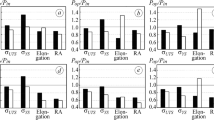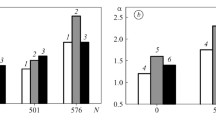Abstract
In the article subject matter associated with endurance analysis of the pipeline of fresh steam was brought up with using the finite element method calculations described at the work allowed for the validation of effected modernizations of the arrangement of fastening. It enabled also to determine the technical condition of the pipeline and to suggest of further solutions in the destination of the improvement in the work of the object [1].
Access provided by Autonomous University of Puebla. Download conference paper PDF
Similar content being viewed by others
Keywords
1 Introduction
They are playing fastening the pipeline important part in the correct work of the installation. The proper selection and the use are ensuring the permanent vitality of the object long and consequently smaller running costs. Also a safety is a relevant aspect of the correct work of the element. Inadequately acting can cause fastening the collision with the supporting structure and creating the stress concentration in material of the pipeline [2].
Therefore in the following article he was brought up with problem of correct conducting the structural analysis of pipelines of fresh steam after the modernization of permanent-weight suspensions. A wrong work of the system of fastening the pipeline in the hot state which it caused was a reason of the exchange wrong dynamic transfers of permanent-weight suspensions from one putting the thermal state in the work in the second estate. Two thermal states of the work of the pipeline of fresh steam are being distinguished:
Cold condition - it is state of the pipeline in which triggered burdens of the increased temperature aren’t appearing, the pressure and the weight of the factor. Powers working on the pipeline come exclusively from the weight of the pipeline along with insulatio.
Hot state - it is state of the pipeline in which the full load is appearing. Burdenit is triggered both with the temperature, the pressure and the weight.
While passing the pipeline from the state of the cold food to hot dynamic transfers are appearing, tied they are with the increase in powers of threshold permanent-weight suspensions. Threshold powers are needed for overcoming internal resistances of suspension at passing the pipeline from one thermal state in second. During the long-term work of suspensions threshold forces are increasing, contributing for big burdening springs what in consequence is leading to, of damaging fastening [3].
The pipeline of fresh PK-1 steam is linking the outlet chamber of the pot with the steam manifold of the block I-go. The course of this installation along with the emphasized scheme of abutments and suspensions is showing Fig. 1. Border of steam OP-130 pipeline / (PK1) are: from the side of the pot: belonging to the pipeline welded joint behind the bolt of the OP-130 pot and in front of the correcting reducer belonging to the pipeline from the side of the interceptor [4].
Scheme of the pipeline PK-1. [5]
Parameters of fresh steam flowing through this pipeline are raising: nominal pressure pr = 7,2 MPa, the working temperature tr = 500 °C, he density of steam in the state of the work \( \delta_{p} \) = 23,3 \( \frac{kg}{{m^{3} }} \) [3].
A geometrical and exploitation following parameters taken into account stayed in calculations of this device: dimension of cross sections of the pipeline Ø298,5 × 17,5, length lK1 = 37,7 m, insulation thickness t = 200 mm, density of the isolation \( \delta_{i} \) = 140 \( \frac{kg}{{m^{3} }} \), working hours of the pipeline tK1 = 102 975 h.
The analysed pipeline is made of steel 15HM(13CrMo4-5), of which mechanical properties and endurance for the room temperature and high equal 500 °C they presented in the Tables 1, 2 and 3.
These properties next were exploited, as the input for defining the model of material in endurance calculations with using the finite element method [8].
2 Geometrical and Numerical Model
For the purposes of endurance calculations a geometric model drawn up of the pipeline stayed. On account of the little thickness of the partition wall in comparing to his external diameter a cover model was defined received after through conducting the coating by the middle of the thickness of his partition wall. By analogy in the destination of more late reflecting the work of the pipeline, was modeled also clamping rings of his supports. Additionally on ends of the installation a flow limiting solid models of bolts of steam was situated (Fig. 2). This way the geometric model drawn up was digitized with the finished respective elements [9].
The discreet model was drawn up among others with coating elements Tinsell type CQUAD4. They reflected with them the geometrical form of the course of the pipeline and clamping rings of supports, their thickness they accepted as corresponding to the real dimension of the partition wall of this organising elements. The number of finished elements took out 28989 [10].
Propping the pipeline was carried out after through getting transfers and turnovers back after all axes in the initial place of the pipeline. The end of the pipeline from the side of the interceptor was blocked this way so that the pipeline as well as the interceptor had free crosswise axes X and Y. The freedom in these axes allows for transfers connected with the thermal expansion of the interceptor. Longitudinal transferring the pipeline was blocked. Turnovers were also frozen in all directions. Suspensions were performed with spring objects of the type 1D CELAS2 (Fig. 4) corresponding to the stiffnesses of these springs hanger The contact of the surface of clamping rings of fastening and the pipeline was carried out with the SURFACE CONTACT. Objects CELAS2 they were fixed in three pivots in the upper hub [11, 12].
Determining straining the pipeline two cases of his work discussed to begin with were considered of article. A work of the pipeline is the first case in the cold state. Such a state is straining the pipeline only a gravity working on mass of pipeline and thermal insulation. (Figure 3) a second estate is a hot state. The work in these conditions differs than previous, that to the burden resulting from mass a triggered burden of field is reaching with the temperature, mass and the pressure of the factor [13].
3 Calculations
Four variants of the work of the pipeline were analysed. The first variant is a pipeline in the cold condition before the modernization of suspensions. A second case is an object in the hot state before the modernization of suspensions. Two another coincidences it by analogy to two first but in the state of the pipeline after the exchange of fastening permanent-weight. Below chosen results of the simulation were indicated on the Figs. 5, 6 and 7 [3] (Fig. 8).
4 Analysis of the Results
Made simulations allowed to get the row of information about the work of the object. Collected data was drawn up and presented in collective tables (Tables 4, 5 and 6).
According to obtained information this pipeline in accordance with the law isn’t subject right EU on account of the year of the production. It is possible to determine acceptable stresses of the connection with it based on the value of acceptable stresses. Value these faces oneself from the model \( S_{d} = \frac{{S_{w} }}{f} \) where \( S_{d} \) – acceptable stresses expressed in MPa, \( S_{w} \) – value tense acceptable of material in the operating temperature expressed in MPa and \( f \) – coefficient of reduction of stresses which he is taking out 1,65. It follows that the allowable stress for the operation of the pipeline at 20 °C is 175 MPa, while during operation at 500 °C is 102 MPa [12].
5 The Summary and Conclusions
Analyzing the obtained values of displacements and reduced stresses, it can be concluded for the pipeline before and after modernization that the modernization of fasteners had a significant impact on its operation. The displacement increments after modernization along the transverse axes X, Y have been reduced, which indicates an increase in the stiffness of the pipeline fastening system in these planes. The further operation of the pipeline for its fastening system characterized by larger displacements could damage the structures located in the vicinity of the pipeline as well as itself. At the same time, the increase in the displacement of the structure in the direction of the Z axis, after structural changes, revealed the incorrect fixing work before modernization, i.e. the fixtures blocked the pipeline in its movements. The movement of the pipeline in this longitudinal direction is not considered harmful due to the compensation of these movements by means of vertical fastenings. Referring to the value of stresses, the pipeline under the influence of the exchange of fasteners “freed itself”. The consequence of this was the storage of stress arising during operation. These values have been reduced to the limit values. In summary, the structural analysis of the pipeline shows the correctness of measures taken during the modernization of fixed braces. It should be noted, however, that despite the use of new fixings, the stresses arising in the pipeline continue to oscillate within the permissible limits. In order to reduce the value, further adjustment of the remaining fasteners, observation and continuous inspection of the fasteners is proposed [14, 15].
References
Kruczek S (2001) Kotły: konstrukcje i obliczenia. Oficyna Wydaw. Politechniki Wrocławskiej, Wrocław (in polish)
Okrajni J, Twardawa M, Mutwil K, Junak G (2015) Maszyny i urządzenia energetyczne węglowych bloków na wysokie parametry pary. In: Maszyny i urządzenia energetyczne węglowych bloków na wysokie parametry pary, 1st ed., Gliwice: Wydawnictwo Politechniki Śląskiej, pp 374–492 (in polish)
Okrajni J, Twardawa M (2013) Boundary conditions in models of power plant components under thermal loading. 62(1), 28–35. (in polish)
Laudyn D, Pawlik M, Strzelczyk F (2006) Elektrownie. WNT. (in polish)
Shared materials of the company ZEC DIAGPOM sp. z o.o.. Wrocław (2016) (in polish)
Rury stalowe bez szwu do zastosowań ciśnieniowych Warunki techniczne dostawy Część 2: Rury ze stali niestopowych i stopowych z określonymi własnościami w temperaturze podwyższonej,” PN-EN 10216-2:2014-02, 2015(in polish)
Ražnjević K (1996) Tablice cieplne z wykresami: dane liczbowe w układzie technicznym i międzynarodowym. Wydawnictwa Naukowo-Techniczne. (in polish)
Okrajni J (2010) Life and operational safety of power systems and chemical plants. 43(1), 38–63
Rusiński E, Czmochowski J, Smolnicki T (2000) Zaawansowana metoda elementów skończonych w konstrukcjach nośnych. Oficyna Wydawnicza Politechniki Wrocławskiej. (in polish)
Zienkiewicz OC, Taylor RL, Zhu JZ (2013) The finite element method: its basis and fundamentals. Elsevier Science
Farragher TP, Scully S, O’Dowd NP, Leen SB (2012) Thermomechanical analysis of a pressurized pipe under plant conditions. J Press Vessel Technol 135(1):11204
Okrajni J, Junak G, Marek A (2008) Modelling of the deformation process under thermo-mechanical fatigue conditions. Int J Fatigue 30(2):324–329
Twardawa M, Okrajni J (2016) The influence of the grade of materials and their state on the thermo-mechanical behaviour of the chosen power plant components. Solid State Phenom 250:238–243
Okrajni J (2011) Zmęczenie cieplno-mechaniczne oraz wytrzymałość i trwałość instalacji energetycznych. Wydaw, Politechniki Śląskiej (in polish)
Gronostajski Z, Hawryluk M, Krawczyk J, Marciniak M (2013) Numerical modelling of the thermal fatigue of steel WCLV used for hot forging dies. 15(2), 129–133. (in polish)
Author information
Authors and Affiliations
Corresponding author
Editor information
Editors and Affiliations
Rights and permissions
Copyright information
© 2019 Springer Nature Switzerland AG
About this paper
Cite this paper
Dobosz, T., Dominiak, J., Paduchowicz, M., Górski, A. (2019). Structural Analysis of Live Steam Pipelines in the Context of the Replacement System Hanger. In: Rusiński, E., Pietrusiak, D. (eds) Proceedings of the 14th International Scientific Conference: Computer Aided Engineering. CAE 2018. Lecture Notes in Mechanical Engineering. Springer, Cham. https://doi.org/10.1007/978-3-030-04975-1_18
Download citation
DOI: https://doi.org/10.1007/978-3-030-04975-1_18
Published:
Publisher Name: Springer, Cham
Print ISBN: 978-3-030-04974-4
Online ISBN: 978-3-030-04975-1
eBook Packages: EngineeringEngineering (R0)












